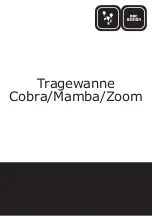
MSXX10, MSXX20 SERIES
63-2607—26
8
Mounting
CAUTION
Device Malfunction Hazard.
Improper shaft coupling tightening causes device
malfunction.
Tighten shaft coupling with proper torque to
prevent damper shaft slippage.
CAUTION
Actuator Damage Hazard.
Using actuator as shaft bearing causes device
damage.
Use actuator only to supply rotational torque. Avoid
any side loads to actuator output coupling bearings.
CAUTION
Equipment Damage Hazard.
Can damage the motor beyond repair.
Never turn the motor shaft by hand or with a
wrench.
Forcibly turning the motor shaft can damage the
gear train.
To mount the actuator to an external drive shaft of a
damper, proceed as follows:
1.
Place actuator over damper shaft; and hold mounting
bracket in place. See Fig. 9.
2.
Mark screw holes on damper housing.
3.
Remove actuator and mounting bracket.
4.
Drill or center-punch holes for mounting screws (or
use no.10 self-tapping sheet metal screws).
5.
Turn damper blades to desired normal (closed) posi-
tion.
6.
Place actuator and mounting bracket back into posi-
tion and secure bracket to damper box with sheet
metal screws.
7.
Using 10 mm wrench, tighten shaft coupling securely
onto damper shaft using minimum 120 lb-in. (13.6
Nm), maximum 180 lb-in. (20.3 Nm) torque.
NOTE:
See Fig. 8 for proper mounting to a square
damper shaft.
Fig. 8. Proper mounting to square damper shaft.
Fig. 9. Mounting actuator to damper housing.
WIRING
CAUTION
Electrical Shock or Equipment Damage Hazard.
Disconnect all power supplies before installation.
Motors with auxiliary switches can have more than
one disconnect.
IMPORTANT
All wiring must comply with local electrical codes,
ordinances and regulations.
DAMPER SHAFT
M21007
M20956
ENSURE THAT MOUNTING ASSEMBLY PREVENTS ACTUATOR
ROTATION AND ALLOWS ACTUATOR TO FLOAT ALONG
INDICATED AXIS. WHEN TOO TIGHT, THE RESULTING BINDING
CAN DAMAGE THE ACTUATOR OR REDUCE TORQUE OUTPUT.
THE BRACKET CAN BE BENT TO ALLOW MOUNTING THE
ACTUATOR PARALLEL TO THE MOUNTING SURFACE.
1
PART NO. 5006427-001
1
2
2


































